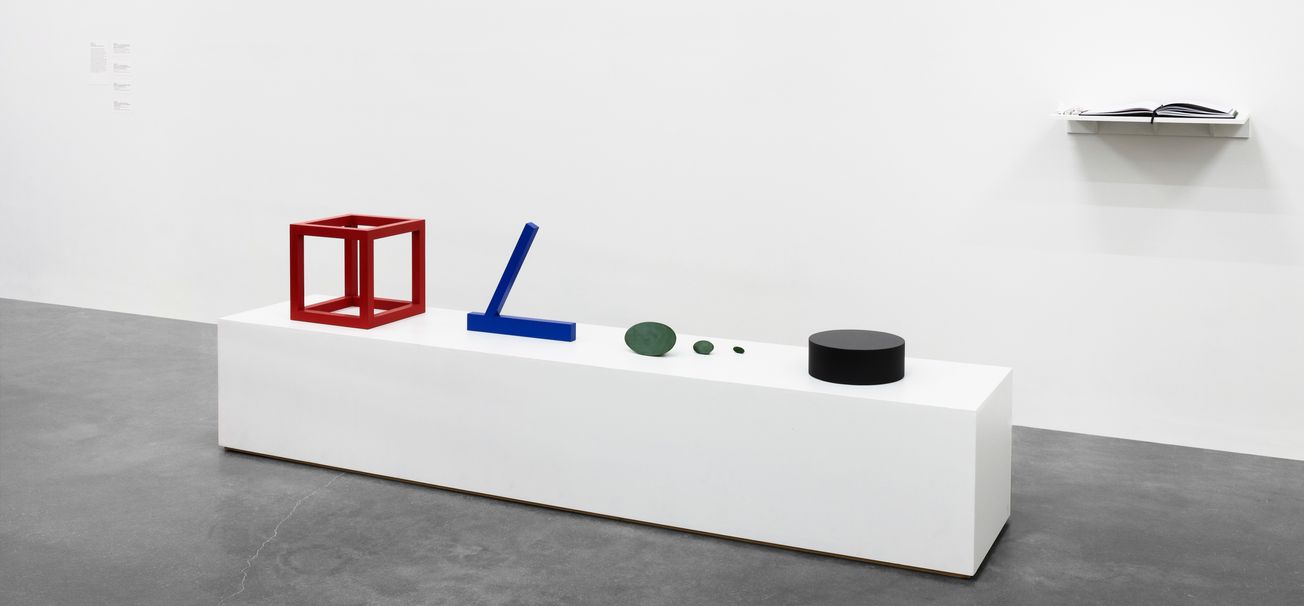Online Arts Editor Helena Raymond-Hayling takes a trip to Spike Island to catch the opening of their new exhibition, featuring the work of Egyptian artist, Iman Issa.
Spike Island is undoubtedly one of the greatest institutions in Bristol. All too often I meet other students who have never heard the name, and those who have are often bemused by its whereabouts (an island? In Bristol?). I implore you, do not be perturbed by the distance from the familiar rolling plains of Redland and the comforting Cotham sands — Spike Island is always a joy to visit.
This international hub of designers, creators, artists and makers from all walks of life will never fail to make you think, with the carefully curated and thoughtfully articulated exhibitions, talks and workshops all year round. Iman Issa's Material for 2018 is no exception.
Join us this Friday for the preview of Iman Issa's new exhibition 'Material for 2018' https://t.co/VPy11JclD8 pic.twitter.com/2pMb63fSw0
— Spike Island (@_SpikeIsland) February 14, 2018
Iman Issa is an artist originally from Cairo, but is now based in Berlin. This show exhibits work from her past 7 years of practice, including her most recent work, Book of Facts: A Proposition.
The philosophy behind her work is that of the instrumentalism of forms, that is, posing the question what makes this object what it is?. She creates her work using the essence of objects, text and words which she finds interesting, and presenting us an alternative version.
See this work by Iman Issa now at Spike Island (here pictured in her recent exhibition at @bielefelder_kv recommended by @frieze_magazine) #Repost
— Spike Island (@_SpikeIsland) February 18, 2018
"One of five minimal objects that make up Iman Issa’s ‘Material for a sculpture commemorating the life of a… https://t.co/MzoxIcZraP pic.twitter.com/QoTzq2sJjT
Upon entering the iconic gallery space, I am greeted by the smell of fresh paint, and a buzzing sea of quirky folk moving round the exhibition and looking (both in earnest and in facade) quizzical and invigorated by the fresh show of works after what feels like an age since Kim Yong-Ik I Believe My Works Are Still Valid.
By artfully stripping all nuance and emotion from her words — Issa creates the space for the listener to impose their own emotions upon the narrative.
Related Content: Why You Should Go and See Kim Yong-Ik’s Exhibition this Autumn
I am instantly drawn to a bench, where I see headphones for the viewer to wear. The Revolutionary is an audio piece which tells a fictional tale of a 'revolutionary', exploring and questioning the semantics of the word 'revolutionary' both what it implies and makes explicit. The narrator describes: 'in many ways, he was a normal man...aside from a few locations, he was mostly unseen', 'a believer, one who believes in the cause...the kind that threw empathy out the door'.
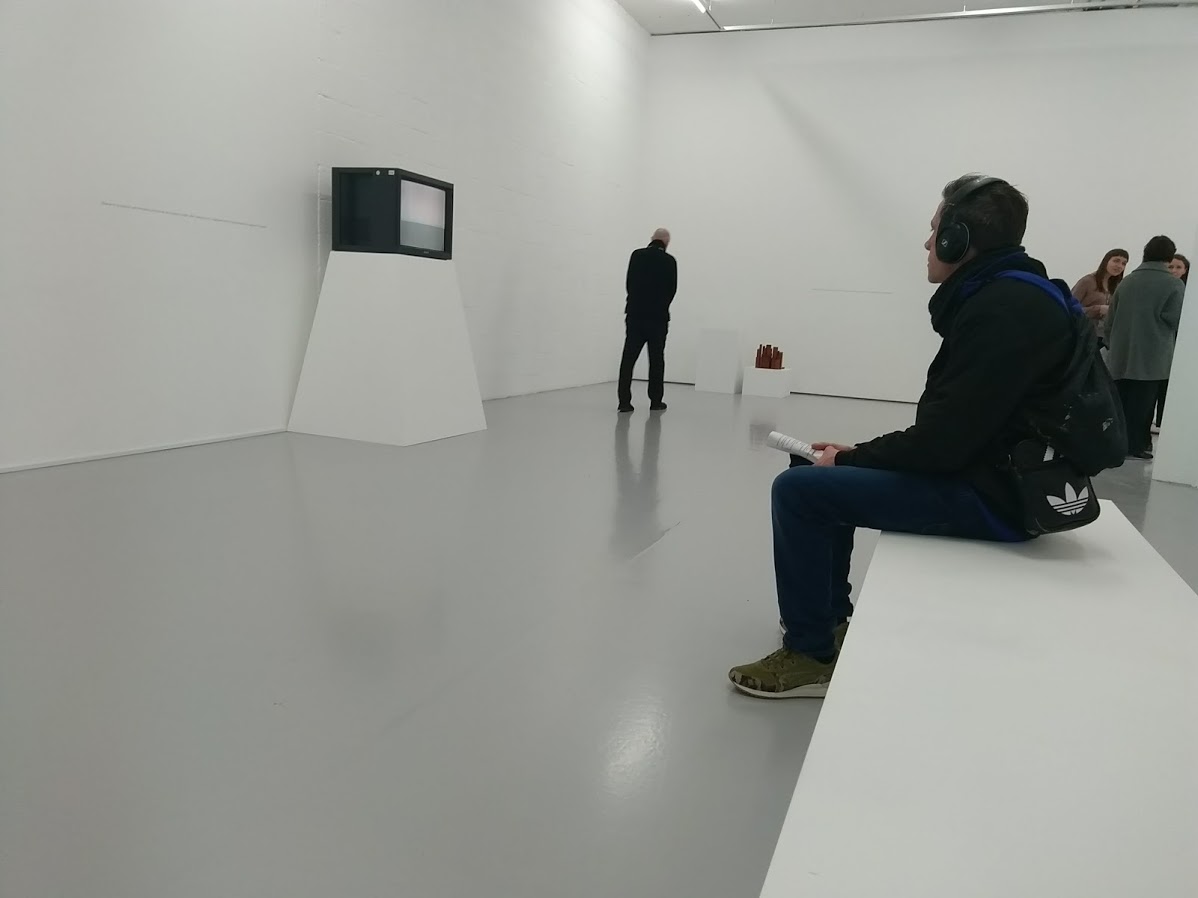
Epigram/Helena Raymond-Hayling
Issa's text is delivered by a text to speech machine, rather than recorded speech — she herself says an actor would have been 'unnecessarily specific'. The use of a lifeless and robotic voice is rooted in Issa's instrumental application of forms. By artfully stripping all warmth from her words — Issa creates the space for the listener to impose their own emotions upon the narrative.
The experience of an audio piece in the expansive and uncrowded Spike Island gallery space was inescapably pensive, and somewhat meditative. I sat and listened to the piece for about three cycles, watching fellow visitors come and go as I did. Some took the headphones and walked about thoughtfully, others put the headset on for a matter of seconds before returning them to the bench. Perhaps the dismantling of linguistic nuance in her work allows her to accentuate certain poignant ideas that resonate with some in an enthralling manner, yet ring hollow with others.
Issa ingeniously entwines me as the viewer, a subject, inseperably with the reality of these objects
Issa's newest work, Book of Facts: A Proposition (2017) is a fascinating guide to an exhibition that doesn't exist, furthermore, the images, documents and photographs in the collection are deliberately omitted from the work, and replaced by an empty frame with a few red marks indicating the locations of elements in the image.
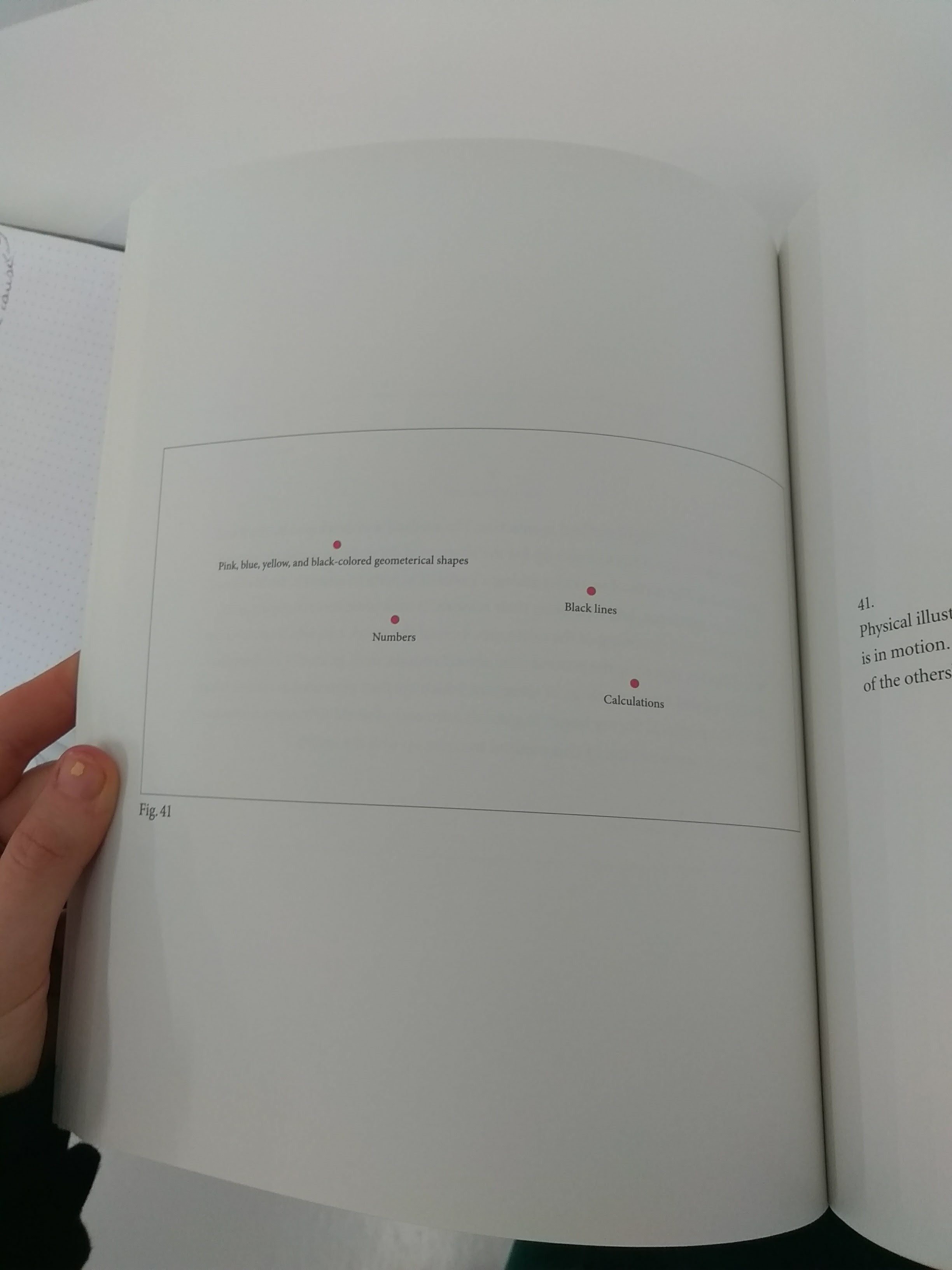
Figure from Book of Facts: A Proposition (2017). Caption reads: 41. Physical illustration. The apparent speed of any oject will change if an ovserver is in motion. In events involving more than one observer, one's time is a mixture is the others' space and time and vice versa.
Epigram / Helena Raymond-Hayling
As I first sit at the table and flick through this book, I am not especially impressed. But after quietening my mind and reading the book page to page I become absolutely absorbed. Every individual page in the book refers to readings of different histories, mythologies, scientific discovery, and muses on grand constructs such as the army and criminal justice.
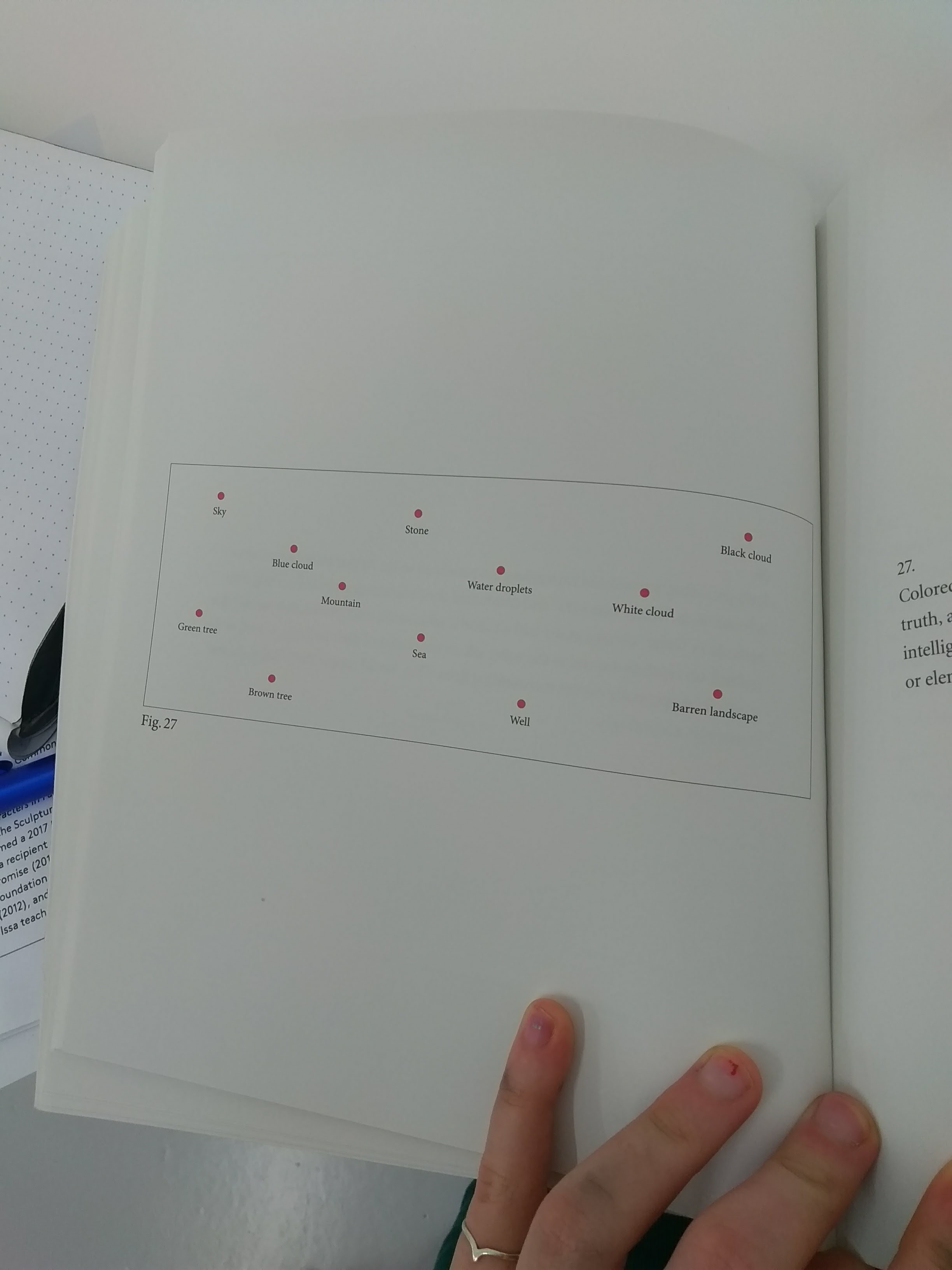
Figure from Book of Facts: A Proposition (2017). Caption reads: 27. Colored scene dividing the world into those who possessed intelligence, goodness and truth, and those who didn't. It shows a landscape without human prescence. Matters of intelligence and those relating to the garnering of knowledge are symbollised by water, or elements related to water.
Epigram / Helena Raymond-Hayling
The pairing of such painfully specific and interesting details and knowledge from across a range of fields with the stark absence of the object being described by this 'exhibition guide' makes for a frustrating yet sensational journey into the mind's eye.
The essence of exorbitant and immovable glorification is troubling to [Issa], and this work explores the capacities in which memorials and monuments are functioning, and how that has changed.
In conjuring such specific images from the imagination in order to construct the seemingly objective truth given in the figure captions joins the subjective with the objective. In doing so, Issa ingeniously entwines me as the viewer, a subject, inseperably with the reality of these objects, the elements of her fictional exhibition.
Occupying the central space in Gallery One is Material (2010–12) a series of 'displays' that question the function of public sculpture and monuments, and to whom they are dedicated.
The series makes reference to existing public monuments which Issa strips back to their essential elements and re-imagines into other forms. The essence of exorbitant and immovable glorification is troubling to her, and this work explores the capacities in which memorials and monuments are functioning, and how that has changed.
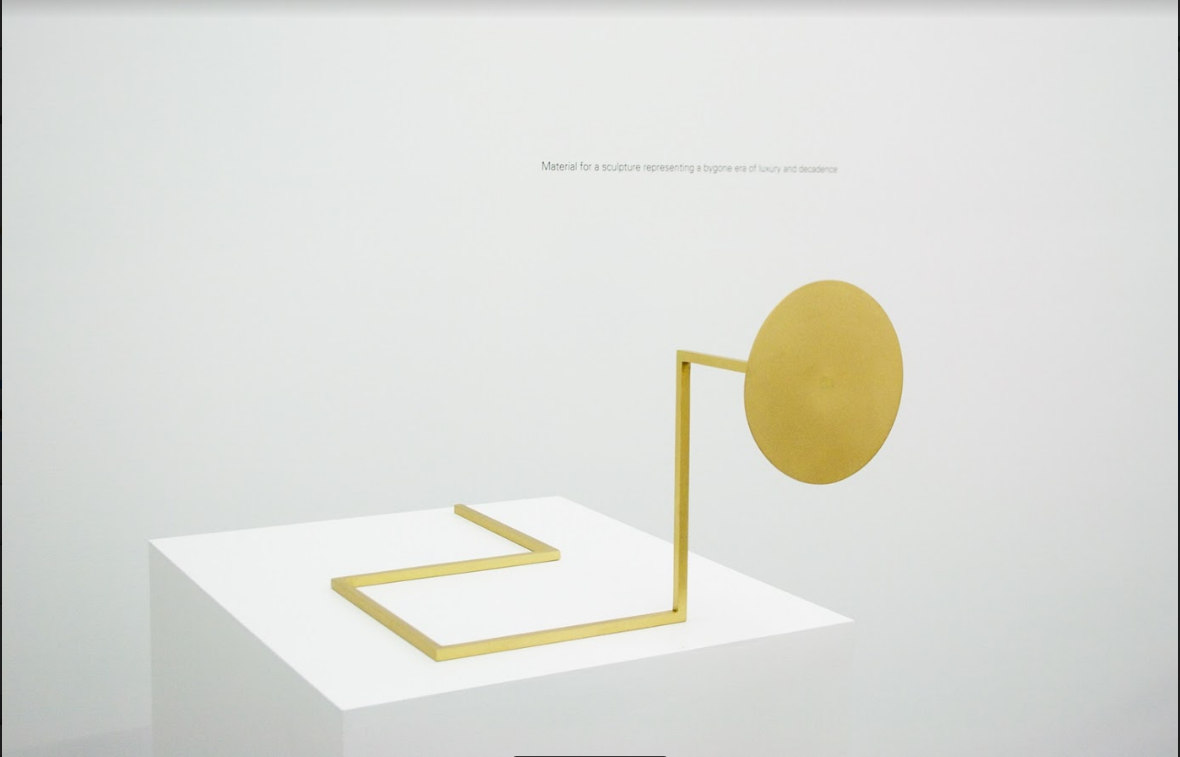
Iman Issa, Material for a sculpture representing a bygone era of luxury and decadence, brass sculpture (29.22 x 63.5 cm), wood plinth (96 x 55 x 47 cm), vinyl text, 2012. Photo: Serkan Taycan.
Interestingly, Issa does not choose to name specificically the people and events referred to by these reconstruction of actual monuments. Of this decision, she says 'the name of the figure or the date of the vent is the least adequate way to recall this figure or event', and that rather than 'removing information', Issa is expressing the information which 'best captured the subject matter being expressed'.
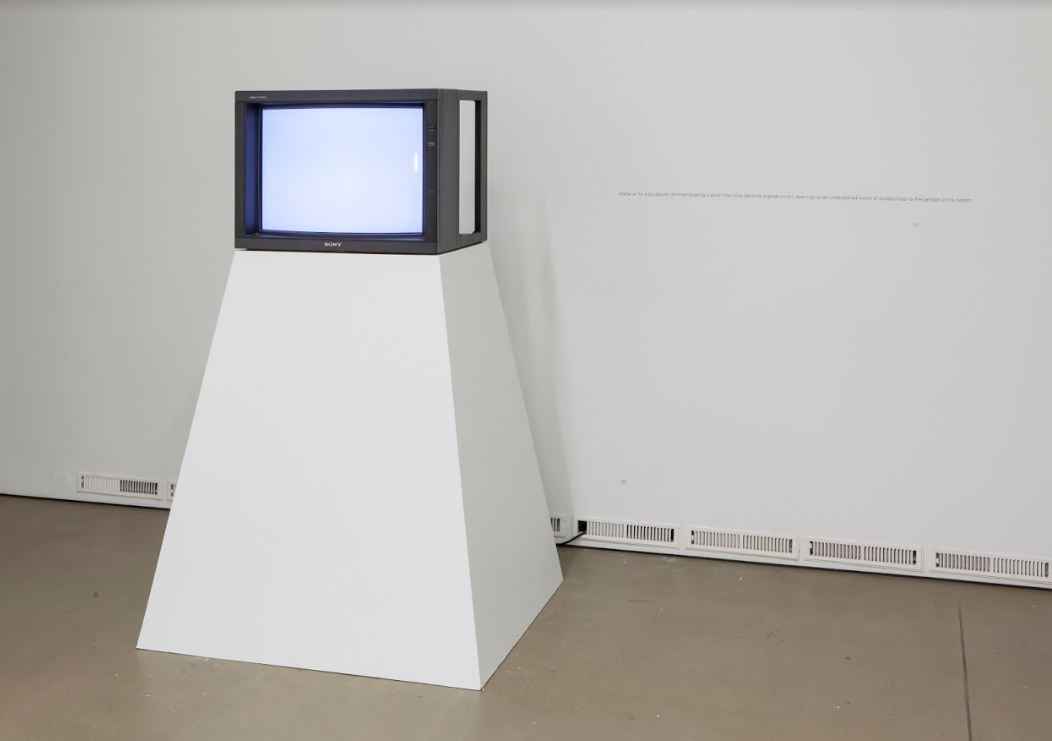
Iman Issa, Material for a sculpture commemorating a blind man who became a great writer, opening up an unparalleled world of possibilities to the people of his nation, video on loop, tube monitor on painted white plinth, vinyl text on wall, 2012. Photo: Serkan Taycan.
These 'displays' suggest the futility of honouring public figures in the form of statues and monuments, if their memory is to fade and their name become meaningless in just a few generations. Worse still, memorials can be erected in the name of oppressive ideologies or to express power in a regime.
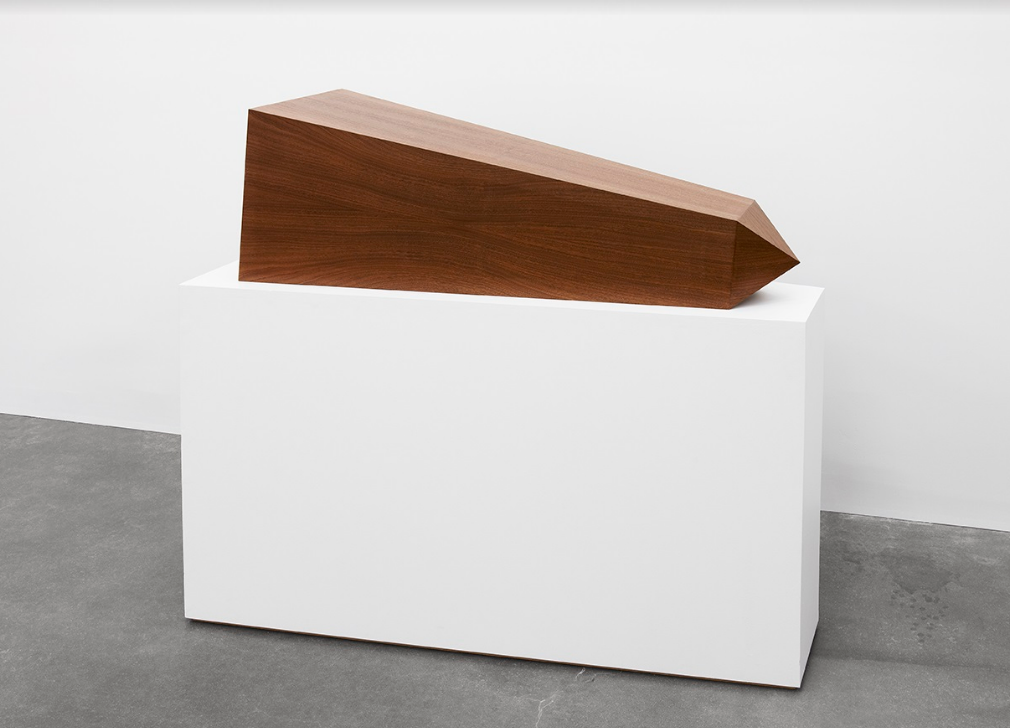
Iman Issa, Material for a sculpture representing a monument erected in the spirit of defiance of a larger power, wooden sculpture, plinth (58 x 58 x 150 cm), vinyl text on wall, 2012. Photo: Benoit Pailley. Image courtesy The New Museum, New York.
We need look no further than Bristol to see this in play, after the contentious discussions about the renaming of Colston Hall, and noting the buildings in our University which were given patronage by controversial individuals (our overlord H.O. Wills) and unscrupulous groups (The Merchant Venturers). With these issues brought to light, the status of the castings of Bristolian pioneers dotted around our streets is called into question, as many of these characters will have been complicit in the slave trade and the oppression of the working class in their time.
Content from BS24/7: Campaign group celebrates Colston Hall rename.
Spike Island is appositely situated in a historical site, and close to Bristol's greatest monument, the SS Great Britain. Revered for its design and magnificence, now retired from its transatlantic service, the ship is a true icon of the City of Bristol, but has a history of use in colonial activity serving during the 1851 gold rush of Victoria, Australia.

Iman Issa, Material for a sculpture proposed as an alternative to a monument that has become an embarrassment to its people, two light bulbs, dark walnut plywood table (150 x 120 x 50 cm), vinyl text, 2010. Photo: Serkan Taycan.
Issa's Material series is compelling not only because of its powerful political themes, but because of its resonance with the surroundings and the history of our beloved city of Bristol. This exhibition is an absolute must-see.
Iman Issa Material for 2018 is open from 17 February to 15 April 2018.
Spike Island are on Facebook // Twitter // Instagram
Featured Image: Iman Issa, Material for a sculpture commemorating the life of a soldier who died defending
his nation against intruding enemies, four painted wood sculptures, wood plinth, wood shelf,blank book with four inserts, vinyl text on wall, 2012. Photo: Benoit Pailley. Image courtesy The New Museum, New York.
What do you think of Iman Issa's work? Let us know in the comments below or on social media

